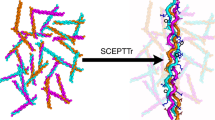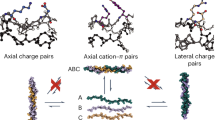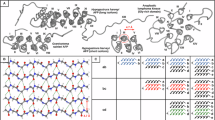Abstract
It has become almost axiomatic that protein folding and assembly are dominated by the hydrophobic effect. The contributions from this, and other, hydrophilic interactions can now be better distinguished by direct measurement of forces between proteins. Here we report the measurement of forces between triple helices of type I collagen at different temperatures, pH and solute concentrations. We separate repulsive and attractive components of the net force and analyze the origin of the attraction responsible for the collagen self-assembly. In this case the role of the hydrophobic effect appears to be negligible. Instead, water-mediated hydrogen bonding between polar residues is the most consistent explanation.
This is a preview of subscription content, access via your institution
Access options
Subscribe to this journal
Receive 12 print issues and online access
$209.00 per year
only $17.42 per issue
Buy this article
- Purchase on SpringerLink
- Instant access to full article PDF
Prices may be subject to local taxes which are calculated during checkout
Similar content being viewed by others
References
Makhatadze, G.I. & Privalov, P.L. Contribution of hydration to protein folding thermodynamics. I. The enthalpy of hydration. J. molec. Biol. 232, 639–659 (1993).
Privalov, P.L. & Makhatadze, G.I. Contribution of hydration to protein folding thermodynamics. II. The entropy and Gibbs energy of hydration. J. molec. Biol. 232, 660–679 (1993).
Sturtevant, J.M. The thermodynamic effects of protein mutations. Curr. Opin. struct. Biol. 4, 69–78 (1994).
Sharp, K.A. & Honig, B. Electrostatic interactions in macromolecules - Theory and applications. A. Rev. Biophys. biophys. Chem. 19, 301–332 (1990).
Novotny, J. & Sharp, K. Electrostatic fields in antibodies and antibody antigen complexes. Prog. Biophys. molec. Biol. 58, 203–224 (1992).
Kauzmann, W. Some factors in the interpretation of protein denaturation. Adv. prot. Chem. 39, 191–234 (1988).
Privalov, P.L. & Gill, S.J. Stability of protein structure and hydrophobic interaction. Adv. prot. Chem. 39, 191–234 (1988).
Dill, K.A. Dominant forces in protein folding. Biochemistry 29, 7133–7155 (1990).
Parsegian, V.A., Rand, R.P., Fuller, N.L. & Rau, D.C. Osmotic stress for the direct measurement of intermolecular forces. Meths. Enzymol. 127, 400–416 (1986).
Leikin, S., Parsegian, V.A., Rau, D.C. & Rand, R.P. Hydration forces. A. Rev. phys. Chem. 44, 369–395 (1993).
Rand, R.P. & Parsegian, V.A. Hydration forces between phospholipid bilayers. Biochim. biophys. Acta. 988, 351–376 (1989).
Rau, D.C., Lee, B.K. & Parsegian, V.A. Measurement of the repulsive force between polyelectrolyte molecules in ionic solution: Hydration forces between parallel DNA double helices. Proc. natn. Acad. Sci. U.S.A. 81, 2621–2625 (1984).
Rau, D.C. & Parsegian, V.A. Direct measurement of forces between linear polysaccharides xanthan and schizophyllan. Science 249, 1278–1281 (1990).
Veis, A. & Pine, K. Collagen Fibrillogenesis. in Collagen (ed. Nimni, M.E.) 113–137 (CRC Press, Inc., Boca Raton, Florida, 1988).
Ripamonti, A., Roveri, N., Braga, D., Hulmes, D.J.S., Miller, A. & Timmins, P.A. Effects of pH and ionic strength on the structure of collagen fibrils. Biopolymers 19, 965–975 (1980).
Li, S.-T. & Katz, E.P. An electrostatic model for collagen fibrils. The interaction of reconstituted collagen with Ca++, Na+, and Cl−. Biopolymers 15, 1439–1460 (1976).
Na, G.C., Butz, L.J., Bailey, D.G. & Carroll, R.J. In vitro collagen fibril assembly in glycerol solution: Evidence for a helical cooperative mechanism involving microfibrils. Biochemistry 25, 958–966 (1986).
Tanaka, S., Avigad, G., Brodsky B. & Eikenberry, E.F. Glycation induces expansion of the molecular packing of collagen. J. molec. Biol. 203, 495–505 (1988).
Rathi, A.N., Padmavathi, S. & Chandrakasan, G. Influence of monosaccharides on the fibrillogenesis of type I collagen. Bioch. med. metabol. Biol. 42, 209–215 (1989).
Hulmes, D.J.S., Miller, A., Parry, D.A. D., Piez, K.A. & Woodhead-Galloway, J. Analysis of the primary structure of collagen for the origins of molecular packing. J. molec. Biol. 79, 137–148 (1973).
Piez, K.A. & Trus, B.L. Microfibrillar structure and packing of collagen: Hydrophobic interactions. J. molec. Biol. 110, 701–704 (1977).
Piez, K.A. & Trus, B.L. Sequence regularities and packing of collagen molecules. J. molec. Biol. 122, 419–432 (1978).
Leikin, S., Rau, D.C. & Parsegian, V.A. Direct measurement of forces between self-assembled proteins. Temperature-dependent exponential forces between collagen triple helices. Proc. natn. Acad. Sci. U.S.A. 91, 276–280 (1994).
Selinger, J.V. & Bruinsma, R.F. Hexagonal and nematic phases of chains. I. Correlation functions. Phys. Rev. A43, 2910–2921 (1991).
Hentschke, R. & Herzfeld, J. Isotropic, neumatic, and columnar ordering in systems of persistent flexible hard rods. Phys. Rev. A44, 1148–1155 (1991).
McIntosh, T.J. & Simon, S.A. Hydration and steric pressures between phospholipid bilayers. A. Rev. Biophys. biomolec. Struct. 23, 27–51 (1994).
Israelachvili, J.N. Intermolecular and surface forces (Academic Press, London, 1991).
Bella, J., Eaton, M., Brodsky, B. & Berman H., M. Crystal and molecular structure of a collagen-like peptide at 1.9 A resolution. Science 266, 75–81 (1994).
Fraser, R.D. B., MacRae, T.P., Miller, A. & Suzuki, E. Molecular conformation and packing in collagen fibrils. J. molec. Biol. 167, 497–521 (1983).
Berendsen, H.J.C. & Migchelsen, C. Hydration structure of fibrous macromolecules. Ann. N.Y. Acad. Sci. 125, 365–379 (1965).
Gerlsma, S.Y. & Stuur, E.R. The effect of polyhydric and monohydric alcohols on the heat-induced reversible denaturation of lysozyme and ribonuclease. Int. J. peptide prot. Res. 4, 377–383 (1972).
Lakshmi, T.S. & Nandi, P.K. Effects of sugar solutions on the activity coefficients of aromatic amino acids and their N-acetyl ethyl esters. J. phys. Chem. 80, 249–252 (1976).
Gekko, K. Mechanism of protein stabilization by polyols: Thermodynamics of transfer of amino acids and proteins from water to aqueous polyol solutions. in Ions and Molecules in Solution (eds Tanaka, N., Ohtaki, H. & Tamamushi, R.) 339–358 (Elsevier, Amsterdam-Oxford-New York; 1983).
Ben-Naim, A. Hydrophobic Interactions (Plenum, New York, 1980).
Mahanty, J. & Ninham, B.W. Dispersion forces. (Academic Press, London, 1976).
Leikin, S., Rau, D.C. & Parsegian, V.A. Measured entropy and enthalpy of hydration as a function of distance between DNA double helices. Phys. Rev. A44, 5272–5278 (1991).
Leikin, S. & Parsegian, V.A. Temperature-induced complementarity as a mechanism for biomolecular assembly. Prot. Struct. Func. Genet. 19, 73–76 (1994).
O'Brien, F.E.M. The control of humidity by saturated salt solutions. J. Sci. Instr. 21, 73–76 (1948).
Author information
Authors and Affiliations
Rights and permissions
About this article
Cite this article
Leikin, S., Rau, D. & Parsegian, V. Temperature-favoured assembly of collagen is driven by hydrophilic not hydrophobic interactions. Nat Struct Mol Biol 2, 205–210 (1995). https://doi.org/10.1038/nsb0395-205
Received:
Accepted:
Issue Date:
DOI: https://doi.org/10.1038/nsb0395-205
This article is cited by
-
Refolding Behavior of Urea-Induced Denaturation Collagen
Macromolecular Research (2021)
-
Impact of Grafting Density on the Self-Assembly and Hydrophilicity of Succinylated Collagen
Macromolecular Research (2020)
-
Structure Restoration of Thermally Denatured Collagen by Ultrahigh Pressure Treatment
Food and Bioprocess Technology (2020)
-
Molecular basis for governing the morphology of type-I collagen fibrils by Osteomodulin
Communications Biology (2018)
-
Molecular modeling of immersion optical clearing of biological tissues
Journal of Molecular Modeling (2018)



